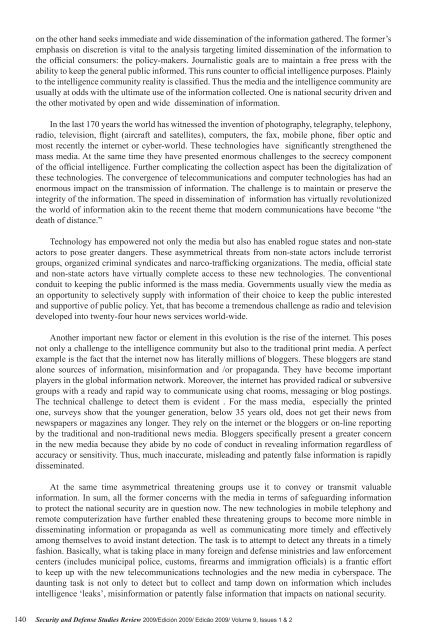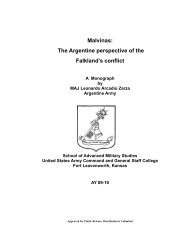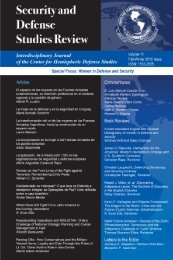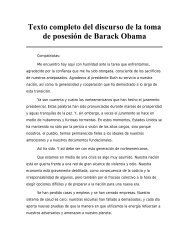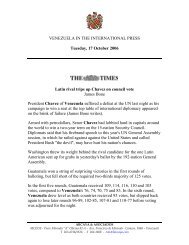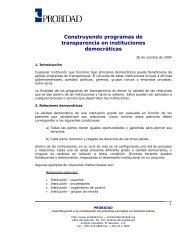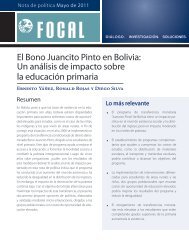Security and Defense Studies Review - Offnews.info
Security and Defense Studies Review - Offnews.info
Security and Defense Studies Review - Offnews.info
You also want an ePaper? Increase the reach of your titles
YUMPU automatically turns print PDFs into web optimized ePapers that Google loves.
on the other h<strong>and</strong> seeks immediate <strong>and</strong> wide dissemination of the <strong>info</strong>rmation gathered. The former’semphasis on discretion is vital to the analysis targeting limited dissemination of the <strong>info</strong>rmation tothe official consumers: the policy-makers. Journalistic goals are to maintain a free press with theability to keep the general public <strong>info</strong>rmed. This runs counter to official intelligence purposes. Plainlyto the intelligence community reality is classified. Thus the media <strong>and</strong> the intelligence community areusually at odds with the ultimate use of the <strong>info</strong>rmation collected. One is national security driven <strong>and</strong>the other motivated by open <strong>and</strong> wide dissemination of <strong>info</strong>rmation.In the last 170 years the world has witnessed the invention of photography, telegraphy, telephony,radio, television, flight (aircraft <strong>and</strong> satellites), computers, the fax, mobile phone, fiber optic <strong>and</strong>most recently the internet or cyber-world. These technologies have significantly strengthened themass media. At the same time they have presented enormous challenges to the secrecy componentof the official intelligence. Further complicating the collection aspect has been the digitalization ofthese technologies. The convergence of telecommunications <strong>and</strong> computer technologies has had anenormous impact on the transmission of <strong>info</strong>rmation. The challenge is to maintain or preserve theintegrity of the <strong>info</strong>rmation. The speed in dissemination of <strong>info</strong>rmation has virtually revolutionizedthe world of <strong>info</strong>rmation akin to the recent theme that modern communications have become “thedeath of distance.”Technology has empowered not only the media but also has enabled rogue states <strong>and</strong> non-stateactors to pose greater dangers. These asymmetrical threats from non-state actors include terroristgroups, organized criminal syndicates <strong>and</strong> narco-trafficking organizations. The media, official state<strong>and</strong> non-state actors have virtually complete access to these new technologies. The conventionalconduit to keeping the public <strong>info</strong>rmed is the mass media. Governments usually view the media asan opportunity to selectively supply with <strong>info</strong>rmation of their choice to keep the public interested<strong>and</strong> supportive of public policy. Yet, that has become a tremendous challenge as radio <strong>and</strong> televisiondeveloped into twenty-four hour news services world-wide.Another important new factor or element in this evolution is the rise of the internet. This posesnot only a challenge to the intelligence community but also to the traditional print media. A perfectexample is the fact that the internet now has literally millions of bloggers. These bloggers are st<strong>and</strong>alone sources of <strong>info</strong>rmation, mis<strong>info</strong>rmation <strong>and</strong> /or propag<strong>and</strong>a. They have become importantplayers in the global <strong>info</strong>rmation network. Moreover, the internet has provided radical or subversivegroups with a ready <strong>and</strong> rapid way to communicate using chat rooms, messaging or blog postings.The technical challenge to detect them is evident . For the mass media, especially the printedone, surveys show that the younger generation, below 35 years old, does not get their news fromnewspapers or magazines any longer. They rely on the internet or the bloggers or on-line reportingby the traditional <strong>and</strong> non-traditional news media. Bloggers specifically present a greater concernin the new media because they abide by no code of conduct in revealing <strong>info</strong>rmation regardless ofaccuracy or sensitivity. Thus, much inaccurate, misleading <strong>and</strong> patently false <strong>info</strong>rmation is rapidlydisseminated.At the same time asymmetrical threatening groups use it to convey or transmit valuable<strong>info</strong>rmation. In sum, all the former concerns with the media in terms of safeguarding <strong>info</strong>rmationto protect the national security are in question now. The new technologies in mobile telephony <strong>and</strong>remote computerization have further enabled these threatening groups to become more nimble indisseminating <strong>info</strong>rmation or propag<strong>and</strong>a as well as communicating more timely <strong>and</strong> effectivelyamong themselves to avoid instant detection. The task is to attempt to detect any threats in a timelyfashion. Basically, what is taking place in many foreign <strong>and</strong> defense ministries <strong>and</strong> law enforcementcenters (includes municipal police, customs, firearms <strong>and</strong> immigration officials) is a frantic effortto keep up with the new telecommunications technologies <strong>and</strong> the new media in cyberspace. Thedaunting task is not only to detect but to collect <strong>and</strong> tamp down on <strong>info</strong>rmation which includesintelligence ‘leaks’, mis<strong>info</strong>rmation or patently false <strong>info</strong>rmation that impacts on national security.140<strong>Security</strong> <strong>and</strong> <strong>Defense</strong> <strong>Studies</strong> <strong>Review</strong> 2009/Edición 2009/ Edicão 2009/ Volume 9, Issues 1 & 2


